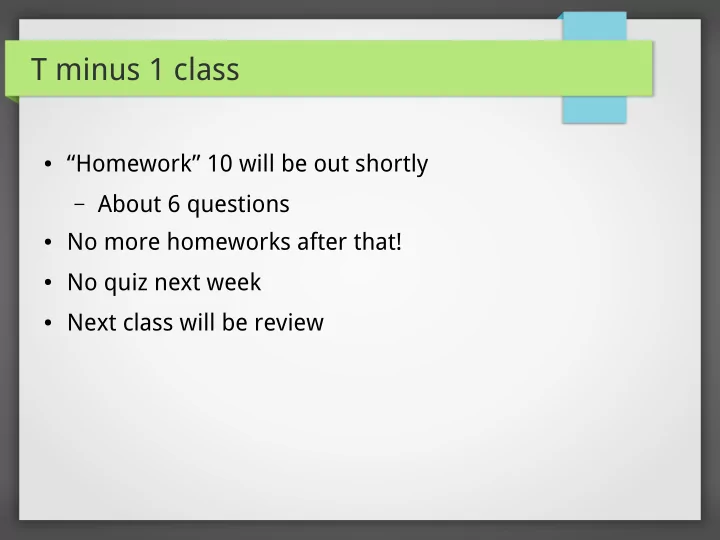

T minus 1 class ● “Homework” 10 will be out shortly – About 6 questions ● No more homeworks after that! ● No quiz next week ● Next class will be review
CMSC 203: Lecture 26 Graphs Cont.
Special Graphs ● Complete Graph: K n – Simple graph that contains one edge between each pair of distinct vertices ● Cycles: C n – Consists of n vertices and edges such that ● Wheel: W n – Add additional vertex to C n and connect vertex to each of the n vertices
Bipartite Graphs ● A simple graph is bipartite if its vertices can be partitioned into two disjoint sets such that every edge connects a vertex in both sets – No edge connects vertices in the same set ● Can be verified if and only if it is possible to assign one of two different colors to each vertex of the graph so no two adjacent vertices are assigned the same color – Known as Graph coloring ● Useful for applications that involve matching elements between sets
Bipartite Example
Representing Graphs ● Adjacency List – For each vertex, list the adjacent vertices – Good for sparse graphs (few edges) ● Adjacency Matrix – 2D matrix of {0, 1}, similar to relation matrix ● 1 if edge from i to j – Good for dense graph (many edges)
Isomorphism ● Two graphs are isomorphic if they are same structure ● You can re-arrange vertices and have identical graphs ● G 1 and G 2 are isomoprhic iff a bijection ∃ f from V 1 to V 2 such that a and b are adjacent in G 1 iff f(a) and f(b) are adjacent in G 2
Isomorphism Example
Graph Invariants ● A property preserved by isomorphism is a graph invariant ● Examples: – Number of vertices – Number of edges – Degrees of vertices must be the same ● Failing above invariants means graphs are not isomorphic (but this is not true in reverse)
Isomorphism Example
Path ● A path is p is a set of edges such that: – p.start = e 0 .start – p.end = e n .end – e n .end = e n+1 .start ● Basically, a series of edges from a start vertex, following connected edges, until an end vertex ● If p.start = p.end, it is a cycle ● If no edge is repeated, it is simple
Connectedness ● Two nodes are connected iff there is a path between – Otherwise, nodes are disconnected ● If every pair of nodes is connected, then the graph is connected – Otherwise, graph is disconnected ● A connected graph contains a simple path between every pair of vertices
Components ● A connected subgraph of G that is not a proper subgraph of any other connected subgraph of G is a connected component ● A connected graph has 1 connected component, whereas a disconnected graph has 2+
Cuts ● If removing a vertex increases the number of connected components, that vertex is a cut vertex ● If removing an edge increases the number of connected components, that edge is a cut edge ● If no such cut vertex or cut edge exists, the graph is called nonseparable
Cut Practice
Shortest-Path Problems ● Useful on weighted graphs where weights are costs ● The length of the path is the sum of the weights of edges in the path ● We minimize the path length between two vertices ● Examples: – Airplane flight time – Driving to minimize time, gas, fares, etc. – Time to send messages
Cost as Fare
Cost as Time
Dijkstra's Algorithm ● Finds shortest path in O(n 2 ) time ● Asymptotically fastest shortest-path algorithm, given: – single-source – arbitrary directed graphs – unbounded weights – non-negative weights
Dijkstra's Algorithm ● Greedy Algorithm – Start with C = {X} – Search for neighbors of C for next closest vertex not already in C ● Add the new vertex to C ● Repeat until end point is the next closest point
Dijkstra Example
Recommend
More recommend